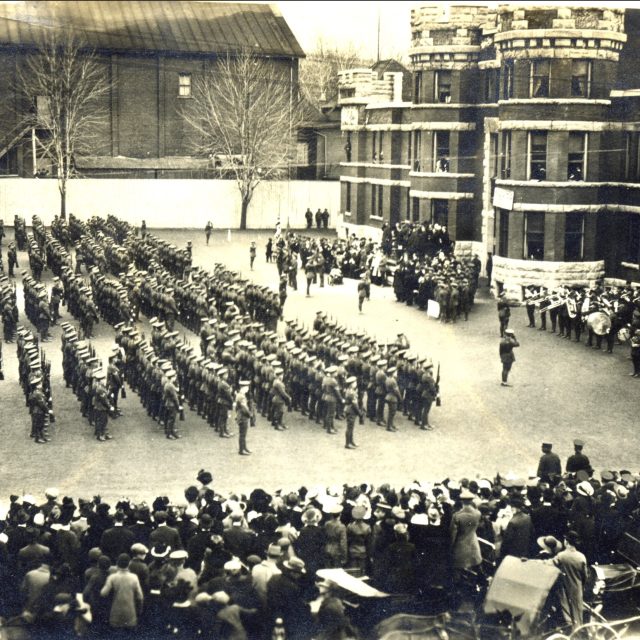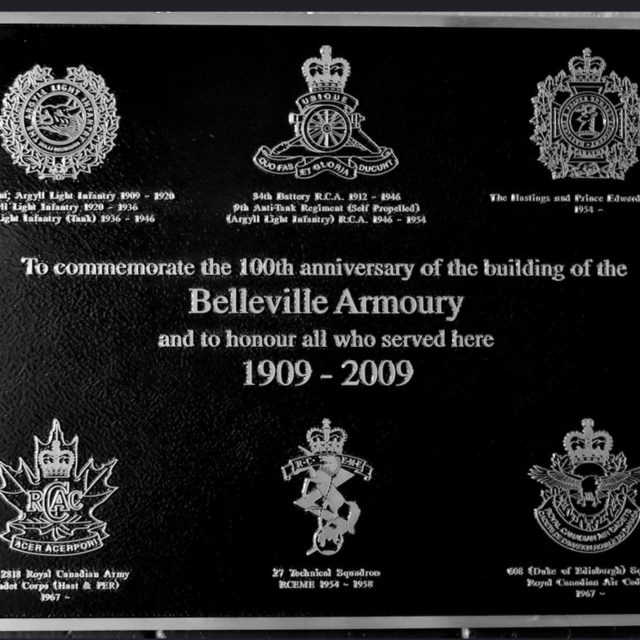
Standing Tall – The Armoury Story
STANDING GUARD
THE ARMOURY STORY
Author: Connie Carson
Connie is a well-known local story-teller and professional who has a passion for the history of the City of Belleville, in particular, the downtown streets.

The Armoury is a well-known, distinguished landmark in our historic downtown area,
and home to the Hastings and Prince Edward Military Regimental Museum.
Because of its rich historical, architectural, and heritage value to the city, the
Government of Canada has declared the Armouries a Recognized Federal Heritage
Building. The imposing structure resembles a medieval fortress with three-storey tall
towers on either side of rugged double troop doors, enhancing the bastion effect from
the street.
THE PROPERTY
Dr. George Cooper, born in Scotland, emigrated to Belleville in 1819 and established a
very successful Druggist and Chemist practice. He founded a Sunday School in 1826
and was one of its teachers.
In 1830 he built a beautiful home surrounded by lush gardens on the corner of East
Bridge and Pinnacle Street. (Present location for the Armouries). Dr. Cooper suffered
from ill health and died in 1836 at only 42 years old.
The property’s history is unclear for the next 20 years, but the deed holder from 1853 to
1878 was Dr. James Lister. Dr. Lister was closely connected to the military and was a
commissioned Surgeon-Major of the 15th Hastings Battalion in 1866. The unit
frequently used his spacious home and gardens as a meeting place for many functions.
His son, Dr. James Lister, also served in the Battalion simultaneously with his father. Dr.
Lister senior passed away in 1878 from pneumonia.
Dr. Benjamin Seymour Willson bought the property, plus the adjacent Opera House, and
resided there from 1883 to 1892. He was elected Mayor in 1888, served on the council
and was also County Coroner for several years. He passed away in 1892.
Dr. William Youker occupied the property from 1896 until he died in 1899 from an
appendicitis operation, and The Dominion of Canada has been the registered owner
since 1929.

THE POLITICIAN
On May 14, 1847, in Upper Canard, Nova Scotia, Sir Fredrick William Bordon, a
physician, businessman, militia officer, and politician, was born. After graduating from
Harvard Medical School in 1868, he became an assistant surgeon in the 68th (Kings)
Battalion of Infantry.
He was also a member of the parliamentary militia lobby and an ongoing participant in
the summer militia camp at Aldershot, Nova Scotia.
In 1896 he became the Minister of the Department of Militia and Defence and initiated a
program to build 100 new armouries and drill halls across the country. In 1903 Belleville
was chosen as the location to construct a new drill hall for the Active Volunteer Militia.
THE OLD DRILL HALL on Church Street
At one time, company armouries were scattered across the city in out-of-the-way
places, and a location was required that was large enough to muster in a drill during the
winter months. In 1891 a Drill Hall at 190 Church Street was built near the corner of
East Bridge and Church Street (behind the current Armouries). It housed the 34th
Battery of the Regiment of Royal Canadian Artillery.
The roof collapsed in 1901 following a snowstorm; it was condemned in 1902 and torn
down in 1903. The Drill Shed was rebuilt on a much smaller scale several years later
and used for training until the 1940s.

THE ARMOURY on BRIDGE STREET
On October 21, 1907, Sir Frederick Borden laid the cornerstone to mark the
construction of a brand-new Armoury in Belleville, Ontario. The 15th Regiment-Argyll
Light Infantry officially moved into their impressive new Drill Hall on February 23, 1909.
Between three and four thousand people attended the gala event to celebrate the brave
men of the 15th Argyll’s. Lieutenant-Colonel Ponton gave one of his typical rousing,
prophetic speeches at the opening ceremony, announcing, “The time may come soon
when the Mother Country will be in the death grips of a struggle for her life. When the
time comes—as come it will—she will expect Canadians to be ready—and they will be
ready!”
From the Daily Intelligencer February 24, 1909

THE ARCHITECTURE
The Armoury is a low-pitched gambrel-roofed, stone and brick grandiose-style building
with an entry block and gun shed. The massive towers flanking the central entrance,
Fink trusses and narrow vertical windows add to the fortresslike appearance of the
structure.
The intricate detailing, such as string courses, copings, battlements and window
dressings in rough-cut stone, creates a striking contrast in colour and texture with the
red brick walls.
A full-length gallery along one wall overlooks the mess hall, offices and classrooms;
large doors provide access at either end. The walls, 2 1/2 to 3 ft thick, are built using the
rubble construction method and house a massive 4,095-metre Drill Hall. It once featured
an indoor rifle range, bowling alley and billiard room.
THE REGIMENT
In 1916, the Quinte region’s Army, The Reserve Militia, formed eight battalions. Their
bravery in action earned them Battle Honours, including the Battle of the Somme, the
Battle of Arras, the Third Battle of Ypres, the Battle of Passchendaele and the
Hindenburg Line.
On September 2, 1939, the Regiment mobilized and began training with leftover WWI
uniforms and equipment. Some used sticks instead of rifles and wore their own boots
and clothing, but by December 19, they embarked on the HMT Ormonde, a fully
equipped and trained unit. While in a fierce battle and suffering the devastating loss of
many men, they were awarded 28 more Battle Honours. Farley Mowat was a Regiment
platoon commander and Intelligence Officer who wrote world-acclaimed books based
on his experiences called The Regiment in WW2 and And No Birds Sang. He had this to
say in part;
“There was one hidden weapon; one ignored by most of those who calculated military
strength, and yet a weapon infinitely more powerful and ready than any in the official
Armoury. It was called the Militia.”
TODAY
The Army Reserve are citizen-soldiers who train part-time at local armouries throughout
the year and full-time at military bases across Canada during the summer. Reserves
also contribute to NATO deployments and UN Missions. The Armoury has been
standing guard over our historic City Hall, Market Square, and Armoury triangle in the
Downtown District for over a century.
As you stroll along East Bridge and Pinnacle Street, stop for a few moments at the
landscaped parade ground gates and visit the memorial dedicated to the Hastings and
Prince Edward Regiment, affectionately known as the Hasty P’s. The monument, built to
honour the Regiment’s role in World War II, lists the Battle Honours and names of all the
young, brave soldiers who never returned home.
Our community and country offer our heroic Militia a heartfelt ‘THANK YOU FOR YOUR
SERVICE.’
